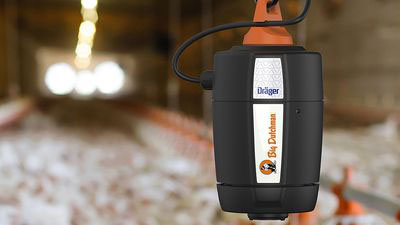



Poultry Climate Control: New Sensor a Milestone for Poultry Production
NETHERLANDS - Big Dutchman will start marketing an award-winning new sensor developed by Dräger with immediate effect: the DOL 53 sensor. Farmers can use this sensor to measure and monitor the ammonia concentration in their poultry houses permanently – for the first time ever.The data provided by the sensor allow the ideal regulation of climate, manure removal and feed management in the barn. With good management, this results in a significant reduction of the ammonia content in the air. Negative consequences on bird health, such as respiratory diseases or footpad infections, are avoided.

Big Dutchman product manager Heinz Südkamp explains the benefits of continuous NH3 measuring: “The birds are healthier, the feed conversion rates improve and the uniformity of the herd is better. For our customers, this means an increase in farm profits and improved animal welfare.”
Permanently monitoring the climate in the poultry house
The winning feature of the DOL 53 sensor is its robust design. Until now, permanently measuring NH3 emissions from barns was a big issue: humidity, dust and especially the aggressive and corrosive ammonia gas itself affected all sensors that were available on the market so strongly that they often did not provide any suitable results after just a short time. This has changed notably with the new sensor. As proven by long-term studies conducted both in the laboratory and in the field, the innovation remains unaffected by temperature fluctuations and humidity changes and is not influenced by other gases such as methane or CO2.
DOL 53 is easy to install in the barn and can be connected to the poultry climate control system. Due to continuous and very accurate data measuring and transfer, the system knows the air’s ammonia concentration at all times and can adjust ventilation rates whenever necessary.
Another outstanding point: the sensor helps efficiently identifying concrete potentials for emission reduction. “Poultry managers can implement modifications directly at the source, for example by changing manure removal intervals,” states Mr Südkamp.
Possible measures include removing the manure from the layer house on additional time per week or optimising the litter management in poultry growing. Both options significantly reduce the NH3 content of the house air. The DOL 53 sensor can additionally be used in manure drying – both in the poultry house and in a connected manure drying tunnel.
Feed: an important parameter
“The wrong feed smells worse!” points out Mr Südkamp, and thus lists another cause for increased ammonia concentrations. Supplying feed with high protein contents in poultry production causes the birds to excrete more ammonia.
The good news: just 2 per cent less protein in the feed can reduce NH3 emissions by 24 per cent. The renowned Poultry World magazine reported on this in their August 2016 digital edition. Formulas for feed, dispensed quantities or more finely milled feed are all parameters that can be changed by farmers who want to monitor ammonia emissions based on the feed they provide.









